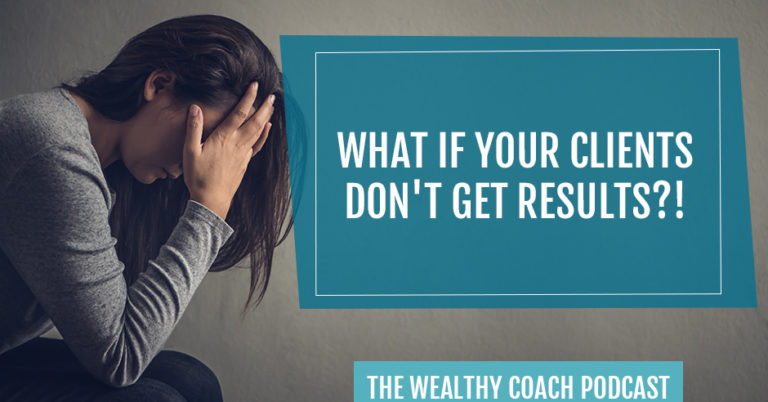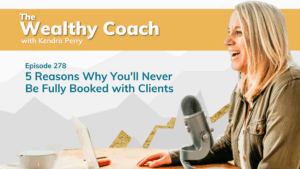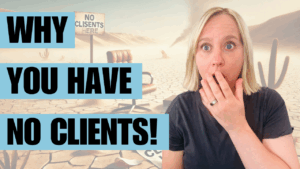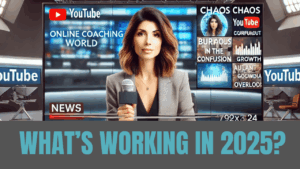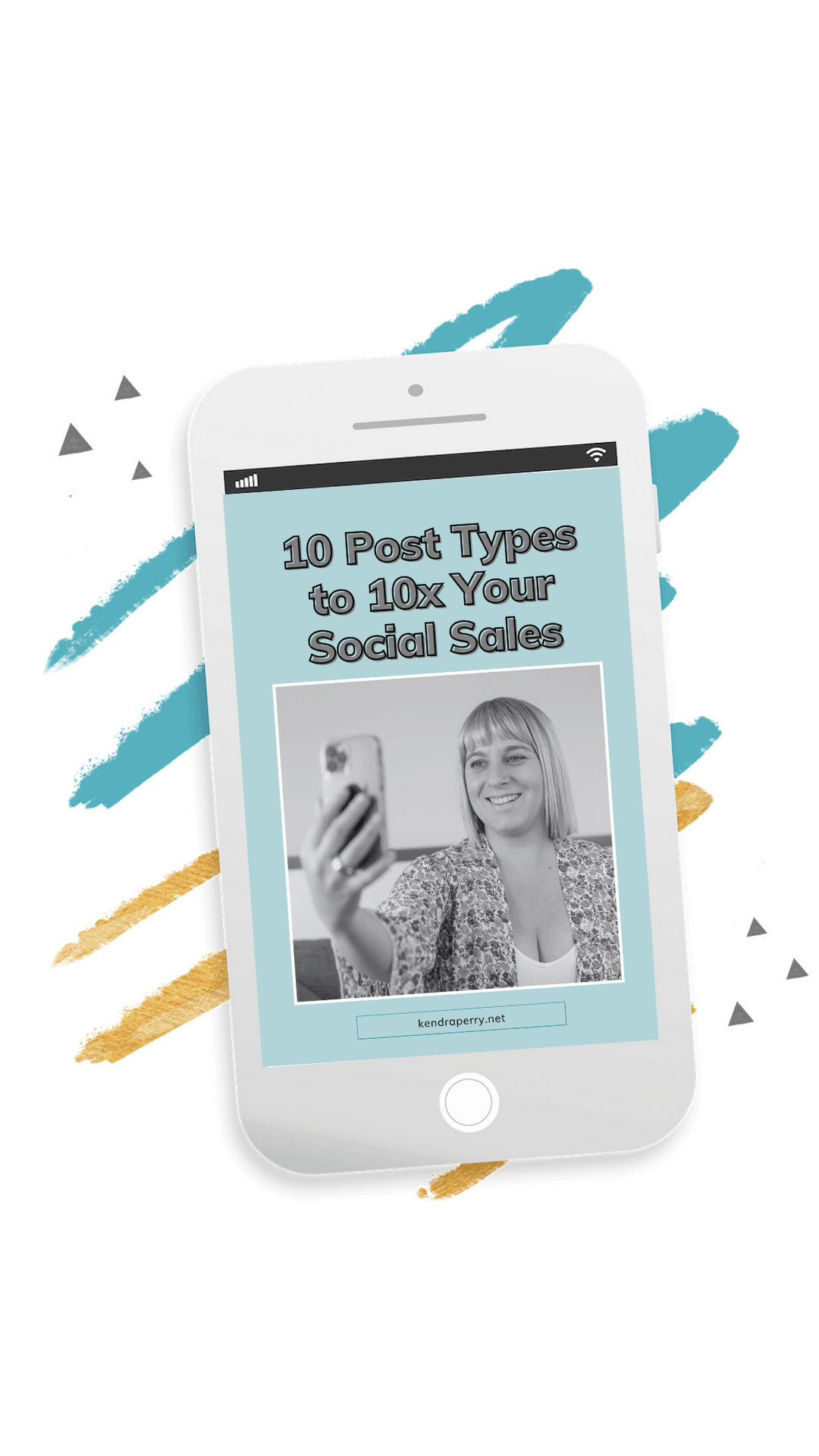Today, we’ll dive into the question that many coaches and practitioners fear: What if your clients don’t get results? As a coach, you’re responsible for helping your clients achieve their goals, but what happens when they don’t see the results they were hoping for? In this episode, Kendra Perry explores the reasons why clients might not get the results they want, even if they’re putting in the effort. She shares six ways that you can consider and take action on that will best set up your clients to get results. She also examines the importance of communication and feedback in the coaching process and how you can use them to help your clients make progress. Whether you’re a seasoned coach or just starting out, this episode is packed with valuable insights and advice that you can use to help your clients achieve success. Join Kendra as she explores the challenges of coaching, and learn how you can navigate them with confidence and grace.
Want to work with me inside Health Coach Accelerator? Start with our free training video: https://go.kendraperry.net/training
Give this podcast a 5-star review: https://RateThisPodcast.com/wealthy
—
Listen to the podcast here
What if Your Clients Don’t Get Results?!
I was supposed to go skiing, but as it turns out, there are these crazy high winds and it’s freaking cold and the chair left isn’t working, which is typical of the resort that I ski at. It’s very much a small-town mountain. It’s not corporatized. There are no condos. There’s nothing fancy up there. That’s why I love it. I don’t like going to the Whistlers, the Big Whites, the bumps, and the Big Mountains because there are always a ton of people. There is not as good skiing because it gets skied out quickly. There’s way more traffic.
I don’t like the condos and restaurants. I’m not into that. I like our little mountain. It shuts down sometimes because it’s ghetto. To be fair, it’s minus 22 and there are high winds. I probably don’t want to be up there anyways. The thing is, we haven’t had a ton of snow this season. It’s been a low snow winter. My desperation to ski powder is extra. A friend of mine and I were like, “Let’s go up. We’ll see if we can get three laps. We’ll do a lap. We’ll go warm up.” That’s how desperate we are.
Anyways, I would’ve been miserable. It would’ve been hell. The trail isn’t running anyway. As it turns out, I get to do this with you instead. How much fun. I love doing shows, so there’s no sarcasm in that. What I want to talk about is something that is probably a massive fear for you. When I ask my students about this in Health Coach Accelerator, this is something that comes up a lot.
We’ve had my mindset coach named Momoko do coaching on this because there is so much fear around, “What if my clients don’t get results? What if my clients think working with me is a waste of money? What if I get a bad reputation for not being able to get people results? This is a fear for not just health coaches, but every coach and practitioner because we care. We want people to see success. Money’s great, but success is important. I feel the same way too. I want my clients and students to get results, and it can feel stressful. You can feel a bit anxious about it and worry, “What if they don’t get results?” That’s what I want to talk about.
I want to put this out there. What if you aren’t in charge of someone else’s results? What if you have very little control over whether someone gets results? Your job is to provide the framework, the information, and the support. If executed, that is going to give them the biggest chance of getting the result. You are there to provide the path, the journey, the framework, and the support, but the rest is up to them. It’s maybe a scary thing to think that we don’t have control over it, but we don’t. We can’t control whether someone takes actions. We can’t control whether someone does the work.
We can’t control all the complexities that might be going on in someone’s body and life that might be preventing them from getting a result. We’re not magicians or wizards. We can only do our best to provide information framework support. That being said, there are a few things that you can consider and take action on that will best set your clients up to get the result. These are the things we do have control over. You want to take your focus off whether they’re going to get resolved and put the focus on the things that you can control that are best set up to get that result.
Explain What The Journey Looks Like
This is important in health and wellness. It’s important in business too. The first thing you can do is to explain what the journey looks like in advance to start with that. For example, in my Health Coach Accelerator Program, my first module is mindset. No one comes to me for mindset. I’m not a mindset coach. People come to me for business and marketing, sales, and for getting clients. That being said, the journey is littered with all kind of mindset crap. All these things come up as you build your business because online business isn’t just as simple as putting a sign out on the street and getting people walking into your brick-and-mortar practice. You have to put yourself out there and get attention. That’s going to trigger all kinds of things.
There are going to be a lot of setbacks. When you build a business, you implement all the things and it happens. There’s a lot of rejection, hardship, tears, frustration, overwhelm, and all of those things involved in the business. I like to start with a mindset, be clear on what the journey looks like, and tell people that it’s hard. I don’t like to sugarcoat it because it is hard.
Struggle is a part of starting a business, especially in the beginning, even with the best mentor, the best coach, and the best of everything. You are going to hustle and sacrifice. That is the nature of building a business. If it was easy, everyone would do it and everyone would have businesses, and there’s a reason why people don’t. It’s the harder path, but I believe it is the more rewarding path, free, exciting, and fun path. When we’re talking about the context of health and wellness and personal development, how can you show them in advance what that looks like? You are well aware that healing is not a linear journey.

It’s not, “I eat the right foods. I do the right exercise. I do this. I feel better. Now, I feel the best and I’m done.” It’s going to be this huge scribble. There are going to be setbacks, ups, and downs. You’re going to get better. You’re going to feel worse. You’re going to feel like you’re failing. All the mindset stuff that can come up in building a business can also come up in healing and improving health and wellness. It can be helpful to be transparent about what it looks like and when they come into your program, having a module, lesson, or a handout or something that makes them aware of what it looks like.
When they come up across those things, their symptoms getting worse, the anxiety, the self-sabotage, the wanting to give up, rather than freaking out and being, “What is wrong?” They’re like, “Jane told me about this.” I’m going to reach out to Jane and get support. That way, people know what to expect, and that’s something you can do.
Stop Frontloading Protocols
The number two way that you can help set your clients up for success is to stop frontloading protocols. What do I mean when I say frontloading protocols? The way that I was taught to deliver a protocol inside the many trainings that I did was to take the health history, run labs, look at the health history, look at the labs, and give them the entire protocol in one session.
You’ve probably been taught this too. If you’re someone who runs labs or you’re a nutritionist who maybe creates a protocol from a health history, I want you to think about what that feels like. Imagine coming into a container with a coach. The first time you’ve ever done this, you’re feeling like crap and you learn that everything you’re doing is wrong. Everything you’re eating is wrong. Your lifestyle is wrong. The way you’re socializing is wrong. How you’re cleaning your house is wrong. The way you are putting moisturizer on your body is wrong. The way you’re drinking water is wrong. Everything’s wrong, and they give you a couple of handouts, “Change your whole life.”
Think about how that can make someone feel. I remember when I first did the protocol, I was meant to deliver the clients. In the certification program, they had to run labs on yourself. You were given a protocol from a mentor. At this point in my life, when I did this program, I was incredibly healthy. very committed to my health. I was eating organic paleo. I was prioritizing my sleep lifestyle. I considered myself to be very motivated. I remember getting that protocol and feeling like a failure before I even started. I remember being like, “This is a lot.” It was a lot of supplements and changes, and I was like, “I don’t know if I can do this.”
That’s how I was feeling as someone who not only was pretty far along in their healing journey but someone who was also incredibly passionate about health and wellness. Your people are not passionate about health and wellness for the most part. The only reason they’re working with you is not that they want to learn all this stuff. It’s because they feel like crap and they need help. They’re probably less further along in their healing journey. They might be at the beginning, depending on who you’re working with, and you’re telling them to change everything. What this led to in my own business was a lot of ghosting and people giving up and that made me feel like a failure.
I felt I wasn’t getting them results because they were giving up. I was blaming it on them. They have a role in it but I realized that it was on me. I wasn’t breaking it down for them. This is why I teach my students in HCA how to build an online signature program. Within that program, there is a curriculum. We teach education. We do a good job with niching. We determine who we help and what problem we solve. The program is repeatable. We’re not building a program for every person who comes through the door with every single problem. We are breaking down the journey in that curriculum.
We create a course, but it’s a program and it includes either one-on-one coaching or group coaching. You could take that curriculum and sell it as an online course. There’s something magical about that curriculum because it breaks down the journey step-by-step. It creates your unique methodology that moves people through, and we have milestones along the way. You could imagine that you are standing in front of a huge mountain. You’ve never hiked before and you need to get to the top. You can imagine that feels overwhelming and scary.
What if I provided you with a guide and the guide said, “Don’t think about the top. We just need to go to checkpoint number one.” It’s a kilometer of hiking and once you get there, there’s going to be this beautiful view. We’re going to see a view down the valley. You’d be like, “That sounds okay. Ignore the top. Focus on checkpoint number one.” This is what milestones are inside your program.
Essentially, by milestone number one, you will have done this. By milestone number two, you will have done this. The in-between is the map or the instruction manual on how to get to that first milestone. The reason why this helps your clients get results is that it chunks it down. It breaks up this massive journey that seems impossible into bite-size steps.
When we think about human psychology, this is how people do better at achieving goals. When you look at the bigger goal, “How do I get there? That’s insane. I’ll never get there. I’m giving up. I running away. I’m in the fetal position in the closet, crying my eyes out.” When we say, “Don’t think about the end goal. Break it down into all the steps that you need to get there, and let’s start with step one,” Hopefully, you can see how that can increase your client’s ability to get results.
It’s the same information. You’re providing them with the same protocol, but you are breaking it down, releasing it, teaching it, and giving it to them over the duration of your program versus in that first session. Even if you run lab tests, you can do this. This can feel confusing, “It’s customized based on the lab test. It doesn’t matter.”
I guarantee that regardless of what comes up on a lab test, there are certain things that everyone’s going to need to do. Let’s say your niche is, “I help new moms heal their digestive distress.” They’ve got their gut problems and they’re new moms. They got a lot on their plate. Their lab tests might indicate that they’re deficient in this. They have this X, Y, Z parasite.
I guarantee that all of these moms, regardless of what comes up on their lab tests, are still going to benefit from the same things. They’re probably all going to need a certain type of diet. They’re going to need to do a certain type of sleep routine. Maybe you like to bring in essential oils. Maybe you bring in energy work. Maybe they need a certain mindset. Maybe they need to detox.
There are certain things that everyone is going to need to do. You can build that education into a step-by-step methodology or curriculum. When you present them with the lab tests and you go through, you can show them what’s going on. Maybe you can start them off on the supplements they need, but you can teach them the rest over the duration of your program. You can see how that’s going to be a lot easier for them to execute.
Qualify As Best As You Can
Number three is to qualify as best you can. We only want to work with people who are the right people for our program. There are a number of different ways to qualify. How I teach my students inside HCA is we have them build a program sales page and sell on a sales call. The reason why this qualifies is that we just don’t allow them to book a call, because first of all, our time is valuable.
We don’t want everyone booking a call with us and taking up our time. We qualify them by having them take a look at the sales page. That way, they can see what the program’s about and get a good understanding if the program is for them or not. By the time they get on the call with you, they already know about your program. You just need to give them a bit of extra information, determine if they’re the right fit, and sell them into your program. There’s that process.
In the context of HCA, my program, I don’t do sales calls, but I qualify with a webinar. We go through a webinar. I tell people who’s the right fit, and who’s the wrong fit. Those all act as qualifying steps. By the time they hit the purchase button, they already have a good idea of whether they’re a good fit for the program and what’s going to be required of them inside.
I want you to get away from selling with a health history or a free consult because telling people what’s wrong and giving them valuable information is not necessarily going to make them want to buy. What you want to do is listen. The majority of your time on a sales call should be listening because you can get a good sense of, “Is this problem a big enough issue for them that they are going to want to take action? Do they seem like they want to take action? Do they seem committed? Is what they want, something I can provide them with?”

That qualification is important. Ultimately, you are going to get people into your program who end up not being the right fit, even despite your best efforts. It happens sometimes. It’s okay. We’re going to talk about what to do if that happens in just a little bit. That was number three, qualify this as best you can.
Focus On The Experience
Number four is to focus on the experience of your program. Experience is important. This is how they interact with your program and how you interact with them inside your program. If they have an amazing experience inside your program, even if they don’t get the full result that they want, they are still going to think your program is a good investment. I see this all the time.
I have a lot of students who come into HCA and it takes them a bit longer to get results with their business, but they still promote HCA. They tell their friends about it because they had an amazing experience inside it. They felt supported. They felt everything was delivered well. They felt cared for and learned a lot. You have to keep that in mind too.
We can’t control who gets results and who doesn’t, but we can control the experience of our clients inside the program. You have to be careful with this because experience is important, but boundaries are still incredibly important. You don’t want to provide an experience that over-delivers, allows people to break your boundaries, and where you do the work for them.
There is a bit of a fine line here. I’m struggled with this a little bit as well. When you start handholding too much, doing the work for your clients, and going beyond your boundaries, beyond what you promise them, that can seem like, “I’m being such an amazing coach. I’m going above and beyond.” That can disempower them.
We’re trying to allow them to stand on their own two feet in the context of what we’re teaching them. In the context of what I do in business, in order to be a good business owner, you have to be self-sufficient, self-reliable, motivated, and learn how to problem solve.” If I did everything for my clients, problem-solve with them, or gave them the answer, they would not gain the skills that they need to be successful in online business. You can’t have other people doing the work for you.
This is true for your clients as well. You need to figure out what the line is between providing them the best experience possible, and also having strong boundaries, not doing the work for them, not over-delivering, and not holding their hand. You need to empower them to make choices for themselves, walk on their own two feet, and be able to execute what you teach without you. Keep that in mind when you’re thinking about experience.

A good resource for this is a book called The Power of Moments. It’s an amazing book and it breaks down different things that you can put into programs and experiences to make them memorable. I love it. I’ve used ideas from the book to improve HCA. I highly recommend reading that one. The other one is called Be Our Guest. This is written by Disney. Disney does an amazing job of creating an experience. That is why they are an extremely successful company regardless of what you think about them. They have done a good job giving an amazing experience to their guests. Check out that book as well because there are a lot of good nuggets in that as well if you’re looking to optimize your program.
Be Wary Of Victim Mode Or Entitlement
We are on number five. This one fits into the qualification step, but be wary of those in victim mode or entitlement. Those people are not going to get results and there’s not much you can do to help them until they get out of that mindset. Victim mode is a tricky one because it’s not always apparent when you first talk with the person. You can talk with the person. They can say, “I’m committed. I’m motivated,” but months into your program, you realize there is a lot of victim stuff going on here.
The only way for people to change anything in there is a personal responsibility. Some people get offended by this. They’re like, “Things happen that aren’t people’s fault.” Most of what happens in your life are not your fault. That doesn’t mean you can’t be in a place of personal responsibility. If you are not responsible for your experience, your life, your actions, and your future, you’re not going to get results in any context, health, business, or whatever. You have to be responsible.
I remember this client, Heidi. This was many years ago when I was a health coach. I should not have taken her on as a client. When I talked to her on the phone, she was one of those people who’d worked with all these different practitioners who’d done all these things. She still wasn’t getting results. To me, that’s always a red flag. I’m like, “Is the fact that you haven’t found the right practitioner yet, or is it you? Are you the common denominator?”
I was early on in my business, needed the money, and wanted the experience, so I took her on. It was not a great experience at all because she always had an excuse. All these things were always happening to her in her life. They were never her fault. It was always someone else’s fault and she could never do anything because of X, Y, and Z. There was always some reason why she couldn’t do anything. She was always fighting for her limitations. This is something I’m very aware of with my students, people who fight for their limitations.
I am never going to help someone fight for their limitations. I’m always going to help them see the possibility and focus on what they can do. You should notice this in yourself as well. I’m not just saying you. I’m talking to myself as well. Sometimes we fight for our limitations. Someone gives you a suggestion. “I can’t do that because of this.” You’re like, “What about this?” “I can’t do that because of this.” You know the type of people I’m talking about and you may even do this yourself. I was doing this with one of my coaches two weeks ago.
I was talking to my mindset coach, Neill Williams, about something I was struggling with in my evergreen funnel. She was giving me suggestions and asking me questions, and I was like, “I can’t do that.” She’s like, “Kendra, do you see what you’re doing?” I was like, “Yeah. I’m fighting for my limitations.” She’s like, “Exactly.” I knew I was doing it, but I was doing it anyways. I’m not trying to blame other people and say, “It’s those people.” All of us go through this. I’m in a situation where I have enough conscious awareness that I can see when I’m doing that, shift and flip it, and take action.
If you start to see this in clients, you have to understand that there is nothing that you can do to help them until they move out of victim mode and stop fighting for their limitations. It’s a bit of a tricky situation, but it usually involves having a frank discussion with your clients. You could have a conversation and say, “This is what I’ve noticed. This is coming from a place of love, coming from a place of me being your coach and needing to call this out.”

You might not get the best response. It may be a situation where someone might not be the best fit for your program, but I like to finish hard, uncomfortable conversations like that with, “What is there that I can do to support you? What is it that you’re missing?” and encouraging them. In the end, if they can’t get out of that victim mode, that entitlement, that fighting of limitations, they’re probably not going to get results, and that has nothing to do with you. Keep that in mind.
Consider A Points-Based Symptom Evaluator
We’re on number six now. I wanted to talk a bit about a point-based symptom evaluator. This is not something I teach in my program, but it’s something I’d like to add to my program. When I went through FDN, this is something they gave to us, and I remember they gave it as an Excel document. It was overwhelming. You gave your symptoms a rating from 1 to 5, 1 being pretty mild, not a big deal, and 5 being so bad.
You’d go down every single symptom that could ever exist on this Excel sheet. You went down and you gave everything a point. It then gave you a total of points at the bottom. I love this because you could give this to a client every 90 days or every month. I found this powerful because sometimes people would come to me after working with me and they’d be like, “Kendra, I’m feeling worse. I’m frustrated. I’m not getting results.” I would always say, “I hear you. That’s frustrating, but before we chat next week, I want you to do an assessment.”
I would give them this Excel assessment. “I want you to do this again in the next column.” Their points had gone down. Sometimes, when you’re in the thick of it, it’s hard to be objective. When you’re in the thick of building your business, it’s hard to be objective and you can go down different rabbit holes and why it’s valuable to have a mentor or coach someone to point you in the right direction.
It’s the same thing with healing. When you’re in the thick of it, it can feel hard to notice when things are shifting. Sometimes certain symptoms get worse, you focus on those, and you think you’re not getting better. More than oftentimes, their points had come down. I found that a powerful tool to enter a session with a client who felt they weren’t getting results because I could always say, “You scored 250 points months ago. Now you’re at 195. That’s a huge improvement. I know this is hard. We’re in the thick of it. We’re still healing. We’re still going through all of these things. You’ve improved”
Oftentimes, that was powerful enough that they’d be like, “You’re right. Thank you much.” If you’re an FDN, you could probably get someone to set that up for you. I don’t know if I would try to set that up myself, unless you’re an Excel expert. This is something I’m thinking about giving to my students because this can be powerful in showing people even when they think they’re not getting results, that they’re actually getting results.
Let’s quickly summarize those. I want to talk about steps you can take if your client isn’t getting results. Number 1) We want to be transparent about what the journey looks like in advance. Explain the ups and the downs and how it’s a long game. Don’t sugarcoat the process. Number 2) We want to stop frontloading the protocols and create a step-by-step methodology/curriculum and break the journey down into milestones. This is going to be your online signature program. This is what I help my students do inside HCA, this is all we do.
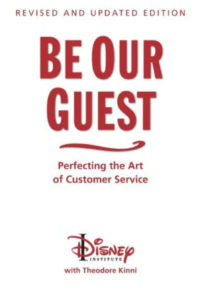
Number 3) You want to qualify as best you can. Use a qualification call. Make sure you have various steps. Number 4) You want to focus on the experience. While we have no control over whether people get results or not, we do have control over the experience inside the program. The two books I recommended are The Power of Moments and Be Our Guest.
Number 5) Be wary of victim mode or entitlement. Understand that when you have someone in those situations, people who are fighting for their limitations, there’s not a lot you can do to help them. That often requires a frank conversation and possibly referring them out to someone else. Number 6) Consider a points-based symptom evaluator. It takes the emotions out and makes it very objective.
Finally, what if your clients are not getting results? Know that there’s always going to be a client who doesn’t get results. It’s the nature of coaching and of being a practitioner. It is what it is. If you have a lot of clients who aren’t getting results, this is going to require a bit of investigation, looking at your program and how you’re offering it. You always want to ask why. “Why is this person not getting results?”
Sometimes you have a tricky situation where a person is committed. They’re very diligent and doing all the work. That might be a situation where they have something more severe going on. There are people who have undiagnosed Lyme disease. They have mold toxicity. They maybe have co-infections. Maybe they have a lot of unknown post-traumatic stress or trauma. They’re unaware of it and it’s causing a lot of health issues. As the practitioner, this is where you need to be aware of when you need to refer out.
Maybe there is something bigger going on and you could refer out to someone who might be a bit more knowledgeable and maybe have more chronic conditions. Maybe you could send them to a trauma counselor or a trauma therapist. We can’t do everything. We can’t know everything. Personally, when I was a health coach, I never took on clients who had Lyme disease. It was out of my wheelhouse. Ultimately, I did have clients who ended up getting Lyme and getting diagnosed later by other practitioners.
I remember one client. I felt was super motivated. She was also a health coach. She was doing all the right things, and I said, “I’m going to be honest. We may have gone as far as we can go. I highly recommend that you work with a functional doctor, someone who can maybe run different lab tests and has a higher knowledge and other things.” As it turned out, she had Lyme disease. That happens. I’m not a Lyme expert. She didn’t know she had Lyme and I don’t blame myself for that. I wish I could have helped her, but ultimately, I wasn’t the right practitioner to help her.
The other thing to think about is whether you can optimize your program. People aren’t getting results. What feedback are you getting? Are they saying, “I’m getting stuck here?” Is there a module that’s overwhelming? Is there a place where everyone always gets stuck? A good way to pick this up as you go is to ask for feedback. If you’re going to get feedback from your clients, you need to create an environment and a space where people feel comfortable coming to you with their concerns.
I love when clients come to me with concerns or they’re upset about something. I love that because as soon as I put my ego aside, I can gain some valuable information. For example, several months ago, I had a student reach out to me and she was like, “I feel uncomfortable doing this. I don’t like to complain, but I feel I paid a lot of money for this program and I’m having a bad experience with this coach.”
I had a coach who was working with me inside a program and they were, they were not having a good experience. When she told me what had happened, I realized that I had to let this person go. It was crappy to let someone go. It put a lot of work on my plate. It was a big ordeal to onboard a new coach. In the end, I was incredibly grateful that this person came forward. If they didn’t come forward, I wouldn’t have known and other students would’ve had similar experiences, which would’ve hurt my business and my program.
It’s important to provide a space where people feel comfortable coming to you with their feedback. It can hurt you a bit to get negative feedback about your program, but it’s always a good thing. Sometimes people give you feedback and you’re like, “I can’t change anything about that,” or they’re wanting something that you can’t offer.
A lot of times, the feedback can be valuable. How I set this up in my program is that at the end of every module, there’s a survey. I give people a little survey and I ask them, “What did you like the most about this module? What did you find the most confusing? What do you wish I had elaborated on? Is there a resource or tool that’s missing that would help you succeed? Is there anything else?”
I add a field for them to put their email address. I don’t make it mandatory. I like that the surveys are anonymous, but I say, “If there’s something you want us to follow up with you on, drop your email address.” Sometimes people will be like, “I’m confused about X, Y, and Z.” I would love to be able to follow up with that person. We give them the opportunity to give us their email address, but they don’t have to. We like them to have the option to have it anonymous as well.
When we’re looking at the reason why people don’t get results, we always want to ask why. We want to see if can we optimize our program. We want to make sure we’re collecting regular feedback about our program so that we can make it better. The only way for you to make your program better is to accept constructive criticism and sometimes negative criticism. It’s a part of it, but know that it’s always going to help you.
Could you be providing more robust support in the program without handholding or doing the work for them? Maybe there is more support that they need. Maybe there’s a different way that you could be supporting them. For example, inside HCA, for a while we were doing weekly reviews. Students could submit things to get feedback on. The coaches and I inside the program would send them a screen recording feedback video, but because it was set up like this, we could only allow them to submit one thing per week, and they had to wait. Sometimes they had to wait up to a week to get feedback.
I realized that this was slowing them down. Instead of giving them immediate feedback on the thing they needed feedback on, they would have to wait. Sometimes, they would submit things where the link was restricted or broken, and we’d have to have them resubmit. I realized not only was this causing a lot of work in my business and for my team. It was slowing down their progress.
We said, “If you need feedback on something, post it in the Facebook group.” We’ll give you feedback within 24 hours. That made the follow-up questioning a lot quicker and it allowed us to give feedback a whole lot quicker. They loved it. Now, they’re moving forward quicker and they loved that.
You have to look at your program even when you think something is super valuable. Our weekly reviews were like, “This is so valuable.” I realized that I was making it less valuable by having all the rules on it. Now, it’s easier for them to post their thing, get quick feedback, and move forward. We always want to be optimizing our program because we do have control over that. We do have control over our ability to extract feedback from our clients and our ability to optimize our program and improve the support that they get.
I’ll be transparent with you. I’m always honest. I have had students come through HCA who don’t get results, but I usually can see exactly why. The truth is, online business is hard. A lot of people go into online business, having no idea what it requires. It’s a hard journey. You have to develop a healthy relationship with rejection, fear, and discomfort. You have to be patient. You have to be willing to wait. You have to take consistent action. You have to be productive. You have to be self-motivated. You have to be the boss.
Some people aren’t made for that and that’s okay. This isn’t for everyone. It’s okay to try something and realize it’s not for you. Some people have a hard time learning new concepts and it’s going to take them longer. I’ve done a lot of work in disconnecting from this attachment to my clients getting results and focusing more on what I have control over. I set them up with a program that I know works and that I’m willing to change, tweak, and optimize based on their feedback to support them within my promised boundaries and knowing that the rest is up to them.
In the context of health and wellness, it’s the same. Not everyone is ready to heal. Not everyone realizes what is required of them in order to heal. A lot of people might think, “With health, I need to do this for 90 days, and then, I’ll be good.” What a lot of people don’t realize is that healing is a lifelong journey. You’re teaching your clients things that they need to implement and work into their lives forever.
It’s an entire change and not everyone is ready to do that. That’s okay. Maybe now is not the time or maybe they’re never going to do it. Instead of focusing on your clients getting results, focus on the experience of the program and making it better because that’s what you have control over. If you focus on that and care about the experience, the program, and how they engage with you inside your program, there’s a good chance that most of your clients will get results. Again, there are always going to be some that don’t. It’s okay and it’s not our responsibility.

I hope you enjoyed this episode. If you love this episode, the best thing you can do is take a screenshot, share it with your Instagram stories, and tag me @KendraPerryInc. Let me know what your biggest take-home was. That helps me get to get a sense of if these episodes are helping you. It’s a very small thing you can do to support the show. I would love that.
If you want to go one step further, you can give this show a five-star review. I would appreciate that. If you love all the content that you get on this show and you want to do that, go to RateThisPodcast.com/wealthy. Thank you much for tuning in. I will see you next time, same time, in the same place where I help you become Wealthy AF.

